Bass Brewery
The Bass Brewery /ˈbæs/ was founded in 1777 by William Bass in Burton-upon-Trent, Staffordshire, England.[2] The main brand was Bass Pale Ale, once the highest-selling beer in the UK.[3] By 1877, Bass had become the largest brewery in the world, with an annual output of one million barrels.[4] Its pale ale was exported throughout the British Empire, and the company's distinctive red triangle became the UK's first registered trade mark.[5]
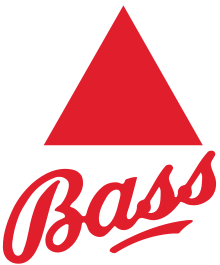 | |
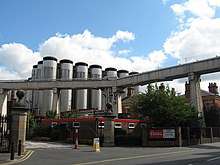 | |
| Industry | Brewing |
|---|---|
| Founded | 1777 |
| Founder | William Bass |
| Headquarters | Burton-upon-Trent, Staffordshire (brewery); Luton, Bedfordshire (Bass brand) , England |
| Products | Beer |
Production output | 365,000 hectolitres (311,000 US bbl) in 2011[1] |
| Owner | Anheuser-Busch InBev (Bass brand) |
| Website | www |
Bass took control of a number of other large breweries in the early 20th century, and in the 1960s merged with Charrington United Breweries to become the largest UK brewing company, Bass Charrington.[2] The brewing operations of the company were bought by Interbrew (now Anheuser-Busch InBev) in 2000, while the retail side (hotel and pub holdings) were renamed Six Continents plc. The UK government's Competition Commission was concerned about the monopoly implications arising from the deal, and instructed Interbrew to dispose of the brewery and certain brands (Carling and Worthington) to Coors (now Molson Coors Brewing Company), but allowed Interbrew to retain the rights to the Bass Pale Ale brand.[6] In 2010, it was widely reported that AB-InBev are attempting to sell the rights to the Bass brand in the UK for around £10 million to £15 million.[3]
Draught Bass (4.4% ABV) has been brewed under contract in Burton by Marston's (formerly a relatively minor competitor) for AB-InBev since 2005.[7][8] Bottled and keg products are brewed at AB-InBev's own brewery in Samlesbury, Lancashire for export, except to the United States and Belgium, where Bass is brewed locally.[9] Bass Ale is a top ten premium canned ale in the UK, with 16,080 hectolitres sold in 2010.[10]
History
1700s
Prior to establishing a brewery, William Bass transported ale for brewer Benjamin Printon. Bass sold this carrier business to the Pickford family, using the funds to establish Bass & Co Brewery in 1777 as one of the first breweries in Burton-upon-Trent.[11]
_%D0%91%D0%90%D0%A1%D0%A1_%E2%84%961-_-_%D0%BB%D1%83%D1%87%D1%88%D0%B8%D0%B9_%D0%B7%D0%B8%D0%BC%D0%BD%D0%B8%D0%B9_%D0%BD%D0%B0%D0%BF%D0%B8%D1%82%D0%BE%D0%BA!.jpg)
1800s
Early in the company's history, Bass was exporting bottled beer around the world, serving the Baltic region through the port of Hull. Growing demand led his son Michael Thomas Bass (senior), to build a second brewery in Burton in 1799 in partnership with John Ratcliff. The water produced from local boreholes became popular with brewers, with 30 operating there by the mid-19th century. His son, Michael Thomas Bass, succeeded on his father's death in 1827, renewed the Ratcliff partnership, brought in John Gretton, and created 'Bass, Ratcliff and Gretton'.
The opening of a railway through Burton in 1839[12] redoubled Burton's preeminence as a brewing town. In the mid-1870s, Bass, Ratcliff and Gretton accounted for one third of Burton's output. A strong export business allowed Bass to boast their product was available "in every country in the globe".[13][14] By 1877, Bass was the largest brewery in the world, with an annual output of one million barrels.[4] In the 1880s the brewery received unwanted publicity through the lifestyle of Frederick Gretton, son of John Gretton. Having worked for the company when a young man, he drifted away and developed a stable of racehorses. His 'Sterling' and 'Isonomy' were stars of the Turf. But 'Fred,' as he was known was also a heavy drinker and took a mistress, the teenage Fanny Lucy Radmall. In later life she would become a household name as Lucy, Lady Houston. When Fred died of drink in 1883 he left her £6,000 a year, much to the disgust of his family.[15]
Following the death of the second Michael Bass in 1884, his son Michael Arthur Bass, later the 1st Baron Burton, took the reins. Both Michael Thomas Bass and his son Lord Burton were philanthropically inclined, making extensive charitable donations to the towns of Burton and Derby. The annual Bass excursions, laid on by the firm for its employees, were the largest operation of its type in the world by a private company. The brewer became a public limited company in 1888.[16]
Bass' No. 1 Ale was the first beer to be marketed as barley wine, around 1870.[17]
Early 1900s
Early in the 20th century, a declining market closed many Burton breweries, 20 in 1900 falling to eight in 1928. Bass took over Walkers in 1923, and Worthington in 1927. They also acquired Thomas Salt in 1927, which was founded in 1774 by Joseph Clay, for over £1,000,000.
Mid-1900s
Bass was one of the original London Stock Exchange FT 30 companies when the listing was established in 1935.[18] Over the next half-century, Bass maintained its UK dominance through acquiring such brewers as Mitchells & Butlers (1961), Charringtons (1967), Bents-Gartsides (1967), John Joule & Sons (1968), William Stones Ltd (1968), and Grimsby's Hewitt Brothers Ltd (1969), being variously known as Bass, Mitchells and Butlers or Bass Charrington. Draught Bass ale and Worthingon "E" were merged to become the same product until Bass became preferred as the name of the cask beer and Worthington for keg, although some pubs resisted this distinction.
Bass had been reliant on railways to distribute its beer from Burton and owned the country's largest private rail network within the town linking its various premises. From the 1970s it followed the trend to abandon the use of rail freight which had become notoriously unreliable. The switch to road haulage required local transport depots, and in many places small independent breweries were bought and repurposed as such. At this time, along with the other major brewers which now dominated the industry, Bass were moving away from the production of traditional ales in favour of keg beer and particularly Carling lager at Warrington, ignoring opposition from CAMRA.
Late 20th Century
In 1988, Bass acquired the rights to franchise the Holiday Inn name outside of North and South America and in 1989 went on purchase the Holiday Inn hotel chain from Holiday Corporation.[19]
Following decades of closures and consolidation, Bass was left by the end of the 20th century with one of the two large remaining breweries in Burton. The brewing operations of the company were bought by Interbrew (now Anheuser-Busch InBev) in 2000, while the retail side (hotel and pub holdings) were renamed Six Continents plc. The UK government's Competition Commission was concerned about the monopoly implications arising from the deal, and instructed Interbrew to dispose of the brewery and certain brands (Carling and Worthington ) to Coors (now Molson Coors Brewing Company), but allowed Interbrew to retain the rights to the Bass Pale Ale brand.[6]
Mitchells & Butlers lives on as the assignee of the licensed retail outlet business, which separated from Six Continents.
Separation of brewery and beer
Bass plc's brewing business was bought by the Belgian brewer Interbrew (now AB-InBev) in June 2000, its hotel and pub holdings absorbed and renamed Six Continents plc.[20]
After the Competition Commission raised potential monopoly concerns,[21] Interbrew disposed of Bass Brewers Limited's Carling and Worthington brands to Coors (now Molson Coors Brewing Company), but retained the rights to the Bass beer brand.[22]
The beer was produced under licence by Coors, which acquired the Bass brewery facility. Bass Brewers Limited was renamed Coors Brewers Limited. When the licence to brew draught Bass came to an end in 2005, it was taken up by Wolverhampton & Dudley Breweries PLC, which started production at Burton's Marston's Brewery. Bottled and keg Bass formerly exported to the US with a higher alcohol content are now produced there domestically by Anheuser-Busch at a Baldwinsville, New York, facility.[23][24]
Brewery museum
Sited next to the brewery, the Bass Museum of Brewing (later renamed the Coors Visitor Centre & The Museum of Brewing), was Burton-upon-Trent's largest tourist attraction until closed by Coors in June 2008. A steering group was established to investigate re-opening,[25][26] and the museum was relaunched in May 2010 as the National Brewery Centre.[27]
Branding
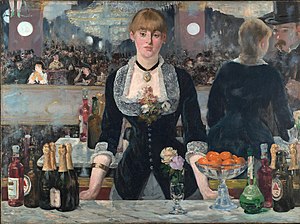
Bass was a pioneer in international brand marketing. "Many years before 1855"[28] Bass applied a red triangle to casks of its Pale Ale. After 1855 the triangles were red, white or blue depending on which of three breweries it came from, but all bottles of Pale Ale had the red triangle from that date.[28] The blue triangle was briefly revived after World War II for Pale Ale that wasn't bottle conditioned. The Bass Red Triangle was the first trade mark to be registered under the UK's Trade Marks Registration Act 1875.[29] The Act came into effect on 1 January 1876 and legend has it that a Bass employee queued overnight outside the registrar's office on New Year's Eve in order to be the first in line to register a trade mark the next morning. As a result, Bass, Ratcliff & Gretton Limited received the first two registrations, the Bass Red Triangle for their pale ale and the Bass Red Diamond next for their strong ale.[30] The trade marks are now owned by Brandbrew SA, an InBev subsidiary based in Luxembourg.[31] In June 2013 InBev renamed Bass Pale Ale as Bass Trademark No.1.[32]
Bottles of Bass with the Red Triangle logo have occasionally appeared in art and literature, including Édouard Manet's 1882 painting A Bar at the Folies-Bergère[33] and in over 40 paintings by Picasso, mostly at the height of his Cubist period around 1914.[34][35][36] In the "Oxen of the Sun" episode of James Joyce's Ulysses, Bloom observes the Bass logo.[37]
Sponsorship
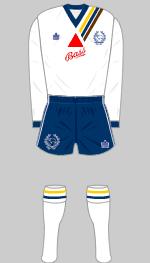
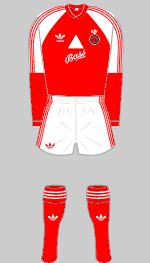
- Bass sponsored Derby County Football Club from 1984 to 1986.[38]
- Bass sponsored Crewe Alexandra Football Club from 1986 to 1989.[39]
- Bass sponsored Blackpool Football Club from 1988 to 1990.[40]
- Bass was the main sponsor of Bristol Rugby for 2006–07.
- Bass was a major sponsor of Pontypridd RFC during the 2009–2011 seasons.
Versions of Bass
Draught Bass
Draught Bass is a 4.4% ABV cask conditioned beer. Most prevalent near its Burton upon Trent and Derbyshire heartlands,[1] it is brewed by Marston's in Burton in Yorkshire Squares using English hops and dry hopping[41] and is described as "a classic ale with a malty, fruity, nutty aroma and a complex, satisfying flavour".[42]
Bass Ale
This is the exported version of Bass, usually brewed to around 5% ABV.
UK keg ales
- Bass Extra Smooth - A 3.6% ABV pasteurised keg version of Bass, brewed to the same recipe, and most popular in the South West of England.[43]
- Bass Mild XXXX - A 3.1% ABV keg mild.[44]
- Bass Best Scotch - A 3.4% ABV keg beer in the North East of England Scotch ale style.[45] It was formerly brewed to 3.8% following its launch in 1986.
Bass overseas
Belgium
Bass Pale Ale has been brewed under licence in Belgium since the Interbrew takeover. It is typically sold in 25cl bottles at 5.2% ABV.
United States
Draught Bass has been exported to America since at least 1966.[47] In 2001, 66,500,000 litres of Bass were sold in the United States.[48] However Bass seems to have suffered under the custodianship of InBev and later Anheuser-Busch InBev as it is undergoing heavy decline in American consumption, with 24,200,000 litres sold in the country in 2010.[48] AB InBev have pledged funding to support the Bass brand in America, and since June 2012, Bass has been brewed in Merrimack, New Hampshire at 5% ABV for the American market.
Elsewhere
In 1860, Bass was the first foreign beer to be sold in Japan.[49]
See also
- Bass Maltings, Sleaford
- Black and Tan, a British drink popular in the US, often made with Bass and Guinness.
- List of breweries in England
- Listed buildings in Burton (civil parish)
References
- Alcoholic Drinks: Euromonitor from trade sources/national statistics
- "Molson Coors (UK)". molsoncoors.co.uk. Archived from the original on 4 March 2010. Retrieved 2 September 2009.
- "AB InBev to offload Bass beer at bargain price". The Evening Standard. Retrieved 4 April 2015.
- "When Brick Lane was home to the biggest brewery in the world". Zythophile. Retrieved 4 April 2015.
- Celia Lury (2004). Brands: The Logos of the Global Economy. Routledge. p. 83. ISBN 978-0-415-25183-9.
- "The British government has ruled that it will allow the Belgian brewing conglomerate, interbrew, to keep Bass Brewers if it disposes of the Carling beer business as it had undertaken. (Business Briefs). Europe > Western Europe from AllBusiness.com". allbusiness.com. Retrieved 2 September 2009.
- "Bass Brewers". quaffale.org.uk. Retrieved 2 September 2009.
- "Marston's PLC". marstonsbeercompany.co.uk. Retrieved 4 April 2015.
- "Samlesbury (InBev UK – InBev)". ratebeer.com. Retrieved 2 September 2009.
- PBA Report 2011 Archived 9 August 2011 at the Wayback Machine
- "Find Out More About Pickfords From 1630 To 2005, With a Complete History of Pickfords Moving and Storage". Pickfords.co.uk. 14 February 2011. Retrieved 19 April 2011.
- "Burton on Trent Local History»Archive » Station History". burton-on-trent.org.uk. Retrieved 4 April 2015.
- A History of the County of Stafford: Volume 9: Burton-upon-Trent (2003)
- A Bottle of Guinness Please By David Hughes
- Crompton, Teresa (2020). Adventuress: The Life and Loves of Lucy, Lady Houston. The History Press.
- Kidd, Charles, Williamson, David (editors). Debrett's Peerage and Baronetage (1990 edition). New York: St Martin's Press, 1990,
- Watts, Henry. A dictionary of chemistry and the allied branches of other sciences, Volume (1872).
- "Financial Times – FT 30 information page". Financial Times. 1 July 1935. Retrieved 19 April 2011.
- Cowan, Alison Leigh (25 August 1989). "Bass P.L.C. to Acquire Holiday Inn". The New York Times. Retrieved 20 December 2018.
- Julia Day (27 June 2001). "Bass to become Six Continents". The Guardian. UK. Retrieved 17 September 2015.
- "The British government has ruled that it will allow the Belgian brewing conglomerate, interbrew, to keep Bass Brewers if it disposes of the Carling beer business as it had undertaken". Food & Drink Weekly. Allbusiness.com. 28 January 2002. Archived from the original on 19 June 2009. Retrieved 19 April 2011.
- Murray-West, Rosie (26 December 2001). "Interbrew sells Carling for £1.2bn". ISSN 0307-1235. Retrieved 30 April 2020.
- "Anheuser-Busch invests $4.5 million in Baldwinsville brewery". syracuse. 23 June 2015. Retrieved 30 April 2020.
- "Why Paying More for Imported Beers Is a Big Waste of Money". Money. Retrieved 30 April 2020.
- Keith Bull (19 February 2009). "Power group set up to save museum". Burtonmail.co.uk. Archived from the original on 15 June 2009. Retrieved 19 April 2011.
- Roger Protz (23 November 2009). "The brewing museum is victory at the barley roots". The Guardian. UK. Retrieved 17 September 2015.
- "HRH The Princess Royal Opens the National Brewery Centre, Burton Brewery Centre". National Brewery Centre. Archived from the original on 29 February 2012.
- The Federal Reporter. 96. West Publishing Co. 1899. p. 207.
- "IPO trade mark 1". Ipo.gov.uk. Retrieved 19 April 2011.
- "IPO trade mark 2". Ipo.gov.uk. Retrieved 19 April 2011.
- "American Beverage Co Ambev – 20-F – For 12/31/04 – EX-4.17". SEC Info. Retrieved 19 April 2011.
- "Bass Ale celebrates its heritage as Bass Trademark No.1". Anheuser-Busch InBev. Archived from the original on 23 March 2015. Retrieved 16 June 2015.
- Kenneth Bendiner, Food in painting: from the Renaissance to the present. Reaktion Books. 2004. p. 73. ISBN 1861892136. Retrieved 4 April 2010.
- "Ma Jolie". Archived from the original on 11 February 2006. Retrieved 2 November 2018.
- "Verre, violon et bouteille de Bass". Archived from the original on 11 February 2006. Retrieved 2 November 2018.
- "Bouteille de Bass, verre et journal". Photo.rmn.fr. Archived from the original on 18 July 2011. Retrieved 19 April 2011.
- "During the past four minutes or thereabouts he had been staring hard at a certain amount of number one Bass bottled by Messrs Bass and Co at Burton-on-Trent which happened to be situated amongst a lot of others right opposite to where he was and which was certainly calculated to attract anyone's remark on account of its scarlet appearance." — Episode XIV, Ulysses, James Joyce (1922).
- "Derby County – Historical Football Kits". Historicalkits.co.uk. Retrieved 19 April 2011.
- "Crewe Alexandra – Historical Football Kits". Historicalkits.co.uk. Retrieved 9 September 2018.
- "Blackpool – Historical Football Kits". Historicalkits.co.uk. Retrieved 13 February 2019.
- "Enhanced Marston's Bass gets trade launch". MorningAdvertiser.co.uk. Retrieved 4 April 2015.
- One Stop Shop
- Bass goes Extra Smooth
- One Stop Shop
- "In Kegs". Archived from the original on 23 March 2012. Retrieved 6 May 2011.
- Britvic
- "Bass, Mitchells & Butlers Limited." Financial Times [London, England] 17 December 1966: 5. Financial Times. Web. 21 August 2011.
- Euromonitor, 2011
- "Double Bass." Financial Times [London, England] 3 November 1995: 15. Financial Times. Web. 21 August 2011.
External links
| Wikimedia Commons has media related to Bass Brewery. |
| Wikisource has the text of a 1911 Encyclopædia Britannica article about Bass. |